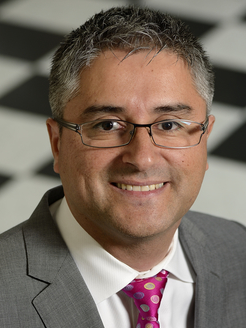- medical image
- control
- chile
Basic Information

(Jul 1974–)
Location: Lautaro, Chile
1. Introduction
Rene Vidal (born 1974) is a Chile an electrical engineer and computer scientist who is known for his research in machine learning,[1] computer vision,[2] medical image computing,[3] robotics,[4] and control theory.[5] He is the Herschel L. Seder Professor of the Johns Hopkins Department of Biomedical Engineering, and the founding director of the Mathematical Institute for Data Science (MINDS).
2. Biography
Vidal did his undergraduate studies at the Pontificia Universidad Catolica de Chile where he received his Bachelor of Science degree in 1995 and his Master of Engineering degree in 1996. After one year at DICTUC he enrolled at the University of California, Berkeley, where he was awarded an M.Sc. and a Ph.D. in Electrical Engineering and Computer Science in 2000 and 2003, respectively.[6] Before joining Johns Hopkins University in 2004, he was a Research Scientist at the Australian National University and NICTA. Vidal is currently a Professor in the Department of Biomedical Engineering of Johns Hopkins University with secondary appointments in Computer Science, Electrical and Computer Engineering, Mechanical Engineering. He is also a faculty member in the Center for Imaging Science, the Institute for Computational Medicine and the Laboratory for Computational Sensing and Robotics. In 2017, Vidal became the founding director of the Mathematical Institute for Data Science.
3. Honors and Awards
In 2004, Vidal was recognized with the National Science Foundation CAREER Awards.[7] In 2009, Vidal was recognized by the Office of Naval Research with an award from the Young Investigator Program.[8] In 2009, Vidal was recognized with a Sloan Research Fellowship[9] in computer science by the Alfred P. Sloan Foundation. In 2012, Vidal was recognized by the International Association for Pattern Recognition by winning the J.K. Aggarwal Prize[10] for outstanding contributions to generalized principal component analysis (GPCA) and subspace clustering in computer vision and pattern recognition. In 2014, Vidal was elected IEEE Fellow[11] for contributions to subspace clustering and motion segmentation in computer vision. In 2016, Vidal was elected IAPR fellow[12] for contributions to computer vision and pattern recognition.
4. Work
Vidal has been a prominent scientist in the fields of machine learning,[1] computer vision,[2] medical image computing,[3] robotics[4] and control theory[5] since the 2000s. In machine learning, Vidal has made many contributions to subspace clustering,[13] including his work on Generalized Principal Component Analysis (GPCA),[14] Sparse Subspace Clustering (SSC)[1] and Low Rank Subspace Clustering (LRSC).[15] Much of his work in machine learning is summarized in his book Generalized Principal Component Analysis.[16] Currently, he is working on understanding the mathematical foundations of deep learning, specifically conditions for global optimality.[17] In computer vision, Vidal has made many contributions to rigid motion segmentation,[2][18] activity recognition[19] and dynamic textures.[20] In medical image computing, Vidal developed algorithms for recognition of surgical gestures.[3] In robotics, Vidal developed algorithms for distributed control of unmanned vehicles.[4] In control theory, Vidal studied algebraic conditions for observability of hybrid systems [21][22] as well as algebraic geometric approaches for the identification of hybrid systems.
The content is sourced from: https://handwiki.org/wiki/Biography:Rene_Vidal
References
- Elhamifar, E.; Vidal, R. (2013). "Sparse subspace clustering: Algorithm, theory, and applications". IEEE Transactions on Pattern Analysis and Machine Intelligence 35: 2765–2781. doi:10.1109/TPAMI.2013.57. https://dx.doi.org/10.1109%2FTPAMI.2013.57
- Tron, R.; Vidal, R. (2007). "A Benchmark for the Comparison of 3-D Motion Segmentation Algorithms". IEEE Conference on Computer Vision and Pattern Recognition. doi:10.1109/CVPR.2007.382974. https://dx.doi.org/10.1109%2FCVPR.2007.382974
- Zappella, L.; Bejar, B.; Hager, G.; Vidal, R. (2013). "Surgical gesture classification from video and kinematic data". Medical Image Analysis 17: 732–745. doi:10.1016/j.media.2013.04.007. https://dx.doi.org/10.1016%2Fj.media.2013.04.007
- Vidal, R.; Shakernia, O.; Kim, H.J.; Shim, D.H.; Sastry, S.S. (2002). "Probabilistic pursuit-evasion games: theory, implementation, and experimental evaluation". IEEE Transactions on Robotics and Automation 18: 662–669. doi:10.1109/TRA.2002.804040. https://dx.doi.org/10.1109%2FTRA.2002.804040
- Vidal, R.; Soatto, S.; Ma, Y.; Sastry, S.S. (2003). "An algebraic geometric approach to the identification of a class of linear hybrid systems". IEEE Conference on Decision and Control. doi:10.1109/CDC.2003.1272554. https://dx.doi.org/10.1109%2FCDC.2003.1272554
- Vidal, Rene (2003). Generalized Principal Component Analysis (GPCA): An Algebraic Geometric Approach to Subspace Clustering and Motion Segmentation (PDF) (PhD thesis). The University of California, Berkeley. http://vision.jhu.edu/assets/VidalPHD03.pdf
- "NSF CAREER Award". https://www.nsf.gov/awardsearch/showAward?AWD_ID=0447739.
- "ONR YIP". https://www.onr.navy.mil/Media-Center/Press-Releases/2009/Young-Investigator-Award-Recipients.aspx.
- "Sloan Research Fellowship". https://sloan.org/past-fellows.
- "J.K. Aggarwal Prize". http://www.iapr.org/fellowsandawards/awards_aggarwal.php.
- "IEEE Fellow". https://www.ieee.org/2014Fellowclass.
- "IAPR Fellow". http://www.iapr.org/news/index.php?id=743.
- Vidal, R. (2011). "Subspace Clustering". IEEE Signal Processing Magazine 28: 52–68. doi:10.1109/MSP.2010.939739. Bibcode: 2011ISPM...28...52V. https://dx.doi.org/10.1109%2FMSP.2010.939739
- Vidal, R.; Ma, Y.; Sastry, S.S. (2005). "Generalized principal component analysis (GPCA)". IEEE Transactions on Pattern Analysis and Machine Intelligence 27: 1945–1959. doi:10.1109/TPAMI.2005.244. https://dx.doi.org/10.1109%2FTPAMI.2005.244
- Vidal, R.; Favaro, P. (2014). "Low Rank Subspace Clustering (LRSC)". Pattern Recognition Letters 43: 47–61. doi:10.1016/j.patrec.2013.08.006. https://dx.doi.org/10.1016%2Fj.patrec.2013.08.006
- Vidal, R.; Ma, Y.; Sastry, S.S. (2016). Generalized principal component analysis (GPCA). 40. Springer Verlag. doi:10.1007/978-0-387-87811-9. https://dx.doi.org/10.1007%2F978-0-387-87811-9
- Haeffele, B.; Vidal, R. (2017). "Global optimality in neural network training". IEEE Conference on Computer Vision and Pattern Recognition.
- Vidal, R.; Hartley, R. (2004). "Motion segmentation with missing data using PowerFactorization and GPCA". IEEE Conference on Computer Vision and Pattern Recognition. doi:10.1109/CVPR.2004.1315180. https://dx.doi.org/10.1109%2FCVPR.2004.1315180
- Chaudhry, R.; Ravichandran, A.; Hager, G.; Vidal, R. (2009). "Histograms of oriented optical flow and Binet-Cauchy kernels on nonlinear dynamical systems for the recognition of human actions". IEEE Conference on Computer Vision and Pattern Recognition. doi:10.1109/CVPR.2009.5206821. https://dx.doi.org/10.1109%2FCVPR.2009.5206821
- Ravichandran, A.; Chaudhry, R.; Vidal, R. (2009). "View-invariant dynamic texture recognition using a bag of dynamical systems". IEEE Conference on Computer Vision and Pattern Recognition. doi:10.1109/CVPR.2009.5206847. https://dx.doi.org/10.1109%2FCVPR.2009.5206847
- Vidal, R.; Chiuso, A.; Soatto, S. (2002). "Observability and identifiability of jump linear systems". IEEE Conference on Decision and Control. doi:10.1109/CDC.2002.1184923. https://dx.doi.org/10.1109%2FCDC.2002.1184923
- Vidal, R.; Chiuso, A.; Soatto, S.; Sastry, S.S. (2003). "Observability of Linear Hybrid Systems". International Workshop on Hybrid Systems: Computation and Control. doi:10.1007/3-540-36580-X_38. https://dx.doi.org/10.1007%2F3-540-36580-X_38
